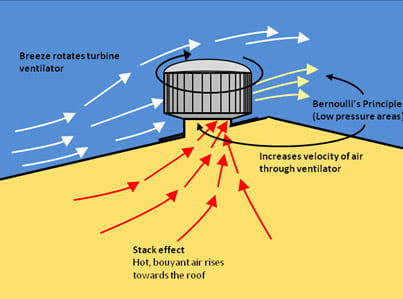By Marwa Naime
Electric power consumption is increasing with time and morphing into a grave environmental concern, where more energy is needed with growing construction. Taking the US as an example, almost 40% of a household’s energy bill goes to cooling in summer and heating in winter, which directly increases its carbon footprint (Energy Star, 2016). One sustainable invention that has proved to be substantially efficient in reducing HVAC consumption is Roof Ventilators (also known as Roof Turbines).
This equipment consumes no electrical power, instead it harnesses the wind’s energy. When coupled with convection, it expels hot air from inside the household or building. By the sun’s radiation, the roof is heated from the outside, which in turn heats the air inside the house or building; naturally, hot air rises to the top of the room, while collecting moisture (increasing humidity), resting above the cold portion where the former is often trapped and raises the temperature of the enclosed space. Hot moist air, which stays trapped inside, causes various problems year-round, like entrapment of pollutants and odors, promotion of mold and mildew growth, rusting of metal fittings and rotting of window sills, and most importantly an increase in cooling power consumption, and hence an increase of greenhouse gases emissions.

Figure source: https://greencountryrooftops.com/services/become-energy-efficient
They key in this technology is the roof ventilators geometry, which is usually dome-shaped and made up of vanes or blades (or baffles depending on the design) which rotate upon contact with wind. The centripetal rotation of the blades allows for the effective expulsion of the exiting hot air towards their tips. Incidentally, this creates a vacuum, which induces a pressure difference, and the hot air inside moves outward to feed the area of lower pressure and gets sucked to the outside through the ventilator. The expelled moist, hot air is replaced by colder, fresh air through any open windows, doors, or through the soffit area of roofs. In winter, roof ventilators prevent the thawing of snow on the roof and the creation of an ice sheet which weighs heavy on the roof and the structure’s joints. Its design, especially the baffled one, prevents rain and snow from seeping in and resulting in negative effects.
The efficiency of these roof turbines is undeniable and have gained considerable popularity. The engineering principle behind this invention is simple and effectual, it is easy to install and affordable, and most importantly it is eco-friendly, eco-conscious, and reduces your household carbon footprint.
References
Bloch, M. (2012, 7). Retrieved from Green Living Tips: https://www.greenlivingtips.com/articles/ceiling-fans-and-roof-turbines.html
Energy Star. (2016, 2 3). Breaking Down the Typical Utility Bill. Retrieved from https://www.energystar.gov/products/ask-the-expert/breaking-down-the-typical-utility-bill ).
